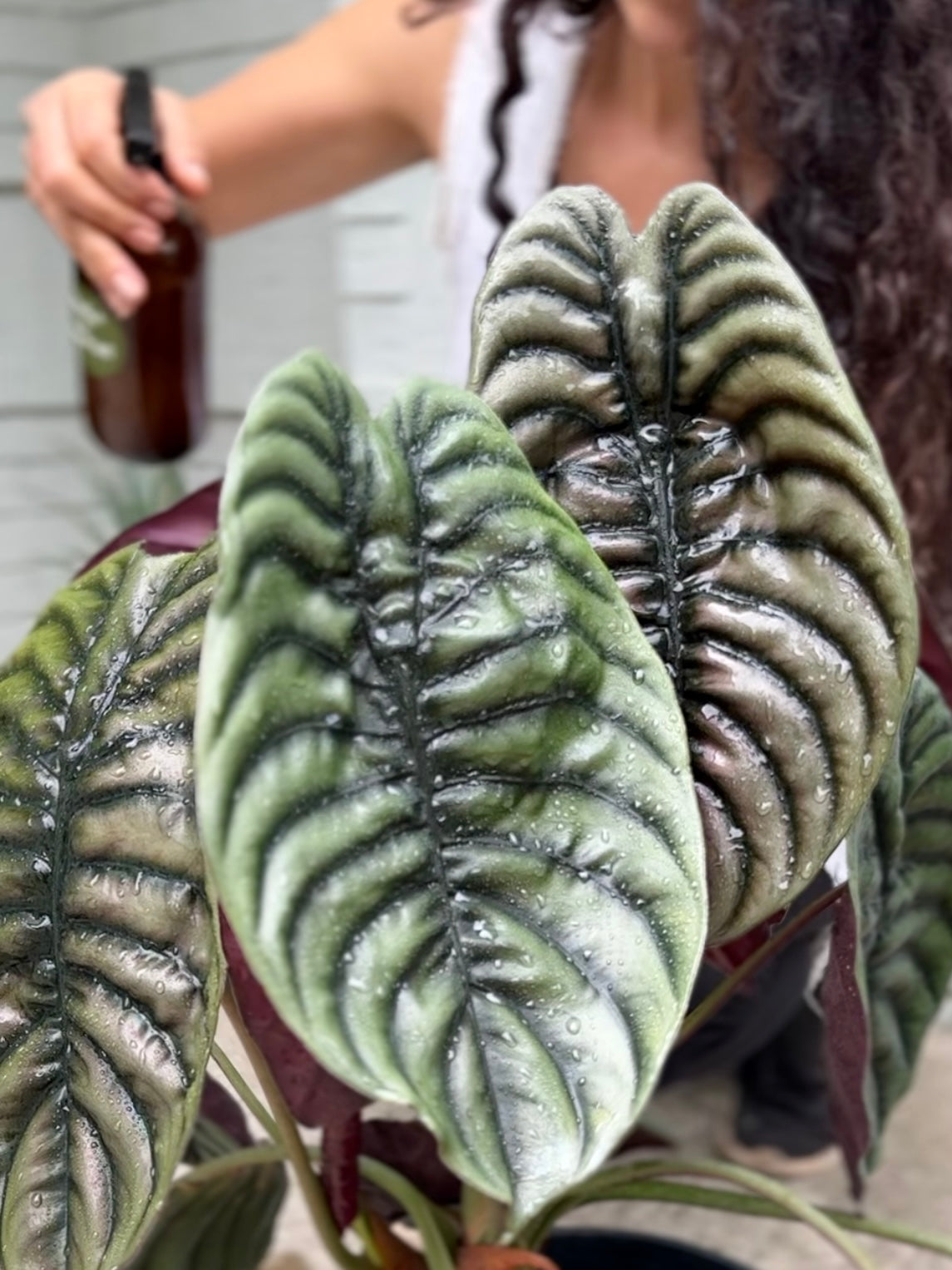
If you discover the telltale signs of spider mites on your plants: tiny webbing, pale color leaves, tiny yellow spots, or miniature spider like critters hiking around the foliage of your plant babies, take a deep breath, exhale, it's going to be ok, we got you!
Let's begin by learning what spider mites love most, chlorophyll and an overabundance of nitrogen.
Chlorophyll
Chlorophyll is the main food source of the flea-like, spiders lookalikes. They love the taste of chlorophyll, the result of photosynthesis, and all its yummy green goodness! Spider mites feed by puncturing the cellular wall of a leaf, and drain it of chlorophyll until the plant or tree (yes, they attack trees too) is no longer thriving. Very sad indeed!
Nitrogen
Spider mites have a sweet tooth, and did you know an abundance of nitrogen in a plant makes it taste sweeter? Since spider mites have an affinity for certain compounds/aromas that are naturally produced by certain plants we can begin to grow those plants to be more resistant. We'll explain how our tonics do that later on in this post or you can hop over to read here
Some houseplants like alocasia, colocasia, anthurium, ficus, palms, calathea, hibiscus, English ivy, cast iron, and cordyline are naturally more appealing to spider mites. In the garden you'll find that tomatoes, parsley, roses, eggplant, corn, peppers, cucumbers, melons, peas and strawberries are the most tempting treats.
But what about un-naturally sweet plants? Plants under attack that don't fall into that list?
Many greenhouse and nursery grown plants are given an over abundance of nutrients so they grow quickly. The side effects? Stressed out plants that lack immunity to ward off disease and pests and far too much nitrogen in their systems. This explains why when you bring home a plant, after a few weeks it shows signs of stress or suddenly has a pest problem. It lacks the ability to acclimate.
Reproduction
Spider mites reproduce at an alarming rate! Because of this, it's vital to keep up with treatment to disrupt the life cycle and fully rid your plants of these pests.
While visiting my father in Florida, he was so excited to show me the plants he'd just brought home. They were big and lush and gorgeous! But after a few days, I noticed they were looking sad and splotchy. Upon closer examination, I discovered an advanced spider mite infestation. Luckily I had packed both 2 oz bottles of our plant care tonics in my carry on luggage!
I was secretly pleased at the chance to show my family first hand how our tonics work and enjoy the process of bringing these beauties back to health! Here's what we learned from a heavy infestation of spider mites:
Treatment
To naturally & effectively treat mites while boosting plant immunity to prevent future infestations here are the steps:
1. Quarantine Do your best to separate plants with spider mites. Take time to look over all plants in your collection and move them to another area in your home or garden.
*Note: If they are small enough, carry your plants to your shower or outside if the weather permits. We recommend showering them off the day after applying Sacred Leaf Tonic to more easily remove the dead mites and debris. It's not necessary, but it is less time consuming in the long run.
2. Removal Cut off all heavily infested leaves and throw them away.
3. Spray Mix up a batch of Sacred Leaf Tonic (and enjoy the aromatherapy)! Out of direct sunlight, spray the entire plant with Sacred Leaf Tonic. Start at the top and work your way down covering back & front of leaves, stems and be sure to get into those crevices where pest like to hide! Then finish with a light spray over the topsoil for any pests moving over the surface.
4. Drench Mix a double dose batch of Sacred Soil Tonic (1/2 teaspoon per 16o of water or 4 teaspoons per gallon) shake and enjoy that foamy, asmr goodness as you drench the soil of the plants you just sprayed.
*Note: A day or two after each application shower down your plant to remove the dead mites and debris. This is not necessary, but we found it to be helpful to speed up the process of ridding your plant of spider mites and also very rewarding to see your plants begin to shine after each treatment!
Schedule
Here’s our schedule to treat any leaf borne pests including spider mites. Be sure to mix according to directions. Our tonics are concentrated and a little goes a long way!
•3-4x applications of Sacred Leaf Tonic during week 1, along with 1x Sacred Soil Tonic drench
•2-3x applications Sacred Leaf Tonic during week 2, along with 1x Sacred Soil Tonic drench
•1-2x applications Sacred Leaf Tonic week 3, along with 1x Sacred Soil Tonic drench
•then you can settle into a preventative maintenance routine after that, we recommend somewhere between 1x a week few months of both the Sacred Leaf and Sacred Soil.
Did you know?
Our tonics are made of 100% organic, food grade, plant based ingredients so you can spray on your skin without worry (it’s actually beneficial) as they are free from synthetics and chemicals, just pure plant medicines that are gentle on people, plants and planet.
 Urban Gardening and Spider Mites
Urban Gardening and Spider Mites
Some crops are spider mite attractors while others are effective at deterring spider mites from attacking your garden. Interplanting these crops in your garden and landscape can help alleviate spider mite infestations.
Mixing crops they love (tomatoes, parsley, roses, eggplant, corn, peppers, cucumbers, melons, peas, strawberries) with crops they avoid (onions, leeks, garlic, broccoli, mustard, cabbage, radishes, parsnips, and herbs like basil, rosemary, peppermint, thyme, cinnamon, chamomile, lemongrass, and dill) is a good way to balance out the garden so spider mites stay far away!
*always apply out of direct sunlight to avoid leaf burn, and if applying to your garden, apply in the evening when pollinators are less active. Our tonics do not harm beneficials but it is always best to avoid spraying them directly!
We're always here to answer any questions along the way. Just send us an email and we'll do our best to guide you to healthier, less stressful growing experience!
With love, Karina and Team SE








Hello Louise, and thank you for your comment. We apologies for the delay in this response!
We suggest spraying them down with a hose or in the shower first, then cleaning the pot, then repotting them in fresh soil and then begin treatment with our tonics.
When dealing with pests like spider mites or scale, do you suggest treating and then repotting them? I had been planning to repot and curious if I should wait until the 4 wks of treatment is up. Thank you!!